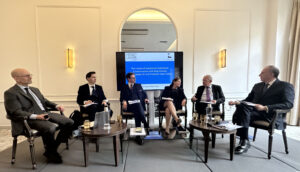As part of Day 1 of the 2023 Paris Arbitration Week (PAW), Laborde Law and Honlet Legum organised a discussion between Meg Kinnear (ICSID, Secretary General), Toby Landau KC (Duxton Hill Chambers), and Prof. Alain Pellet (Paris X University) on “The Future of Investment Arbitration?”. The event was moderated by Gustavo Laborde (Laborde Law), Jean-Christophe Honlet and Barton Legum (Honlet Legum).

In recent years, two opposing dynamics have emerged in investment arbitration: while States are not satisfied with the current system and change seems now to be on foot, there is also great inertia. Desired changes, if any, may take longer than expected. Despite calls for reform and introduction of “small” improvements from time to time (e.g. new arbitration rules), any radical transformation of the system could take years, if not decades. Following an assessment of the current system, the panel set out to distinguish between the near-term, mid-term, and the distant future of the field.
Assessment of the Current System – Does it Work Well?
Toby Landau KC noted that many disputes have been resolved, numerous awards have been enforced, and, as a result, many conflicts have been avoided. Despite this, the system is ill-developed. Its lifespan remains, as of now, very short: the first investment treaty was signed in 1959 between Germany and Pakistan, and there was no active investment arbitration until 2000. During a period of 30-40 years, arbitration was dormant – a sleeping beauty “kissed by Jan Paulsson” with his landmark article “Arbitration without Privity”. Thus, the panel is assessing an incredibly short-lived process, which has only been around for 20 years.
And yet, in that short lifespan, a significant backlash has grown. The future of the system is routinely questioned during conferences, and UNCITRAL Working Group III (“WGIII”) consistently demands change. There is a palpable exodus.
Mr. Landau noted that a trend towards States withdrawing from the system has accelerated.1)In 2019, 37 investment treaties were terminated, 43 in 2020, and 87 in 2021. Considering the difficulties with renegotiating treaties and political obstacles along the way, the investment arbitration system is not a success, and this viewpoint has now acquired a loud voice. While it was perhaps possible to persuade the world five years ago that it is a fair, effective and legitimate system, there is now a mountain to climb to convince the world.

Meg Kinnear contended that although the system is young and criticized, it functions well: more than 2200 BITs are in force (along with 65 model BITs), ICSID has 158 members, 30% of cases are settled, and case law is becoming more and more developed. A lot of negative stereotypes are inconsistent with the evidence – in fact, no international law system has ever evolved and grown as much as ISDS.
Prof. Pellet opined that it is not a good sign that after a few years, the community already questions the future of the field. He qualified several major defects of the system as the “7 capital sins”, namely (i) legal uncertainty, (ii) length and unintelligibility of decisions, (iii) length of proceedings and excessive costs, (iv) too-systematic use of experts, (v) “americanization” of the proceedings, (vi) l’entre-soi, and (vii) doubts regarding certain arbitrators’ and counsels’ conduct.
Against this backdrop, the speakers contemplated the near future of the investment arbitration system.
Near Future – New ICSID Rules and Regulation of Double-Hatting
The panel took the new ICSID Rules and the regulation of double-hatting in the Code of Conduct for Adjudicators in International Investment Disputes (see Art. 4) as examples of improvement of the system in the near future.
According to Ms. Kinnear, the 2022 ICSID Rules address many current concerns, as they:
- aim to reduce time and cost, with (i) tools such as remote filings and virtual/hybrid hearings, and (ii) new time limits – 180 and 240 days time-limits to render a decision on jurisdiction (Rules 44.3 and 58.1) and on the merits (Rules 44.4, 45, and 58.1);
- introduce new techniques such as the case management conference, which enables the tribunal to address the case more efficiently, as well as a mandatory declaration of availability for arbitrators;
- aim to create greater transparency, with all orders and decisions being public alongside the awards (unless agreed otherwise by the parties);
- make it easier for third parties to participate in the process, and include specific provisions on conflict of interests and third-party funding;
- bring more options for dispute settlement (stand-alone mediation rules and a major update of the conciliation rules and the additional facility mechanism).
Even though they constitute a “small progress”, Prof. Pellet also welcomed the improvements on transparency and third-party funding, while regretting a lack of sanctions. Given the system’s bad image and the double-hatting issue remaining unresolved, Prof. Pellet deemed that these amendments would not rehabilitate the perception of the system.
Mr. Landau distinguished two orbits. On the one hand, at the level of the process itself, there are very positive improvements, which will make ICSID tribunals manage cases more actively and avoid ICSID’s “autopilots” such as template documents, which often result in a standard process that can prove to be redundant. On the other hand, bigger existential issues are more pressing, and addressing them seems like rearranging the deck chairs of the Titanic. He noted that this is precisely the case with double-hatting.
Regarding double-hatting, Ms. Kinnear recognized that it is still a work in progress. There are now advocates, including ICSID, in favor of a tempered approach to not dissuade new arbitrators and first-timers.
While recognizing himself as a “double-hatter”, Mr. Landau agreed that this practice raises genuine concerns. However, they have never been successfully addressed. The first concern, i.e., taking a position as counsel that may impact the neutrality of an arbitrator, does not justify a strict ban. Indeed, parties choose their arbitrators because of their previous positions, and it is not expected from arbitrators to come with a blank mind. The second concern is, on the contrary, a good reason for introducing a ban, in Mr. Landau’s view. When combining counsel’s and arbitrator’s work simultaneously or in close time proximity, there might be an incentive to decide a point as an arbitrator that helps a practitioner as a counsel. However, this requires a coincidence of timing, treaties, parties, and issues. That is why he advised the application of a cooling-off period.
Further, if the community moves away from double-hatting entirely, this would be a monumental barrier to first appointments of new arbitrators, while we desperately need diversity. Finally, Mr. Landau emphasized the great difference between full-time arbitrators and arbitrators who also do counsel work; there is something about acting as counsel that keeps you up to date.
Middle Future – New Generation of Treaties and Disputes
Turning to the middle future of investment arbitration, the panel focused on the potential new generation of treaties and disputes.
Ms. Kinnear mentioned several new features in treaty-making, including a more detailed definition of “investment”, the inclusion of denial of benefits clauses, clarified FET or MFN standards, and clauses concerning police powers, health or the environment. A bigger room has been made for mediation, and more and more treaties have new entry-type requirements such as waiver or fork-in-the-road provisions.

Prof. Pellet disagreed that there is somehow a “new generation” of treaties, noting that treaties are longer rather than decisively different. Mr. Landau confirmed that despite changes in treaty-making, smarter treaties are applied in the same arbitral process, with tribunals applying the Vienna Convention over the text of the treaty. In this context, not much has changed indeed.
Conversely, Ms. Kinnear sees a real evolution over time, with a lot more diversity. Around 40% of appointed arbitrators are women, and 12-40% are first-timers. Mr. Landau replied that there is very little change in comparison to other burning issues, in particular, that the process is not owned by the people. Advocating that the arbitral community needs to move to countries desperate to be included, he explained that there is much more to do in this regard. Ms. Kinnear confirmed the “unlimited” need for technical assistance, and highlighted the lack of visibility of some practitioners based in these countries.
Regarding a potentially new generation of disputes, Mr. Landau confirmed that there is already a significant change. Disputes involving sovereign discretion are vertical in nature, with one party attacking a State for a policy that could affect the entire nation. They impact public interests, and put investment tribunals in the middle of incredibly difficult policy decisions. The current procedural model (flowing from a commercial arbitration mindset) is unsuitable. A large range of interests is left out of the process, or with very limited concessions (e.g., amicus curiae). These new disputes require a more robust model that addresses all interests, and that foreshadows the criticism that may come later.
While Prof. Pellet added that these other interests will never be considered if disputes are settled within the classic adversarial system, Ms. Kinnear suggested that this could be achieved through other means such as mediation or conciliation, which enable more viewpoints to be involved in the process. Mr. Landau finally opined that the adversarial system polarizes the process and needs to be rethought, with instruments that allow arbitral tribunals to assess policy in the same way as good governance would formulate it.
What (Ideal) Distant Future?
Turning finally to the more distant future, the panelists were asked what an ideal future for investment arbitration would be. Prof. Pellet replied that, ideally, there would be no investment arbitration system, and domestic courts would resolve investment disputes. The best alternative would be to have a strongly institutionalized global mechanism. More realistically, Prof. Pellet advocated for, at least, a regional mechanism with a robust appellate body. The European Union has already shown that this could be reached soon.
In Mr. Landau’s view, the community should not “abandon” what was achieved until now. The function of ISDS is not to promote FDI, but to force developing countries to elevate their standards. He concluded that his ideal would be a multilateral body, ideally global, but realistically regional, with permanent and diverse personnel. Holding a different view, Ms. Kinnear assessed that the system works well overall, despite needing incremental changes. She wished that people would use the tools that are already available.
Finally, Prof. Pellet noted that this very small world is poisoned by money. Mr. Landau contended that although the increasing criticism will continue, the work of WGIII will reach a point. In the meantime, the EU process will also likely give rise to a regional system, once the current concerns regarding the multilateral court are addressed. Ms. Kinnear believes that policy will focus on access to the system and developing a mechanism that effectively resolves disputes.
Conclusion
In conclusion, Prof. Pellet preferred a “strong regional investment court with an appellate body”, while Ms. Kinnear called for “innovative views on case management conferencing”. Mr. Landau concluded that there must be a change in the arbitral mindset and encouraged the arbitral community to stop treating the system as commercial arbitration and think of it as something totally different. For more details, a full recording of the conference can be watched here.
More coverage from 2023 PAW is available here.
________________________
To make sure you do not miss out on regular updates from the Kluwer Arbitration Blog, please subscribe here. To submit a proposal for a blog post, please consult our Editorial Guidelines.

References
| ↑1 | In 2019, 37 investment treaties were terminated, 43 in 2020, and 87 in 2021. |
|---|


Hey, great job Laborde Law and Honlet Legum for oragnising this and reporting on it. One small comment – The admission of the European Commission as an amicus curiae into a large number of ICSID cases shows that in a formal sense non-disputing party interests are not left out of the process. From a practical point of view, query whether other interest groups provide in their respective constitutions and funding programs for the overhead cost of having an investment arbitration lawyer monitor ICSID’s website for opportunities to intervene in appropriate cases, and then the further direct cost of doing so, and the further potential liability for the costs of the disputing parties in commenting on the non-disputing party submission should the tribunal impose such a condition. It would be a good thing to see more amici getting involved in the process.